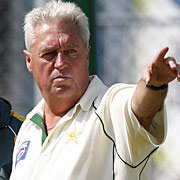The jittery that the Indian equity market is offering right now might make one wonder as to what instruments are right for this kind of conditions. A lot of people had hope in the real estate and infrastructure until the middle of 2006. This does not seem to hold good anymore with the financial minister rolling out a very ordinary Union Budget 2007-08. Interest rates are further heading northward and cement sector has been hammered with additional excise duties stamped on them.
The Indian market, unlike the not-so-recent-past, seems to be reading and vigorously reacting to the global cues. Earlier the upcoming economies and bourses were generally driven by one or two major factors such as global crude prices, local agricultural and manufacturing growth predictions, monsoon/rain forecasts etc. Nowadays FII (Foreign Institutional Investors) activities, far eastern market movements, US employment rates, terrorist threats, Greenspan’s untimely statements (and may be even George Bush’s mother-in-law catching a mild cold) etc seems to be taking the Indian market for a roller coaster ride. The volatility is so high that small-time retail investors are the worst suffered in most cases.
(Before trying to analyze what is the best form of investment going forward, let me put forth a disclaimer. Here I am going to talk only from the view point of young – includes middle-aged persons like me – investors. I cannot really talk on behalf of the older and matured lot of investors.)
Equities for long term
I still believe that equities are the best instruments to meet your long term financial needs. This is because of the fact that no other options could yield good enough returns to beat the high inflation rates. With proper planning it is possible that the equities can yield upward of 12% annualized returns in long term. No other instruments can possibly guarantee this kind of returns on investment. So if you are below thirty or thirty five, it may be a good idea to expose 50% of your portfolio to equity market (stocks or equity oriented funds – both with long term horizon in mind). Now I am sure that most of the youngsters out there have already taken care of this aspect. The missing trick could the ‘long term’ factor. Most of the younger lot that I interact with want fast money that matches their fast lifestyle – This does not quite work with equities. Long term investment is preferred (Tip 1) over risky trading. Also, stock or fund picking becomes easier in this case.
The most critical aspect is in picking the right stocks with long term (10-20 years) value in mind. If you look at the past performance of certain blue-chip companies this may not be all that difficult. But any portfolio will get some extra punch (Tip 2) if it has one or two mid-caps that offers greater mid-term growth. Most of the time the difficult part is picking these strap-on boosters that mostly keep changing in your portfolio every other year or so. In this case one might need professional advice (and not rumours) and help from company research reports. One can afford to have one or two such scrips (Max 15% of your equity exposure) in a portfolio of 12-15 pure long-term plays. If you are sure about your long-term picks, don’t let the market fluctuations affect your decisions. Ups and downs are common in the market and you never loose in holding a good long term play that temporarily goes down. In other words, even if the current market price (CMP) is less than your purchase price, it is only notional. i.e. You don’t loose anything unless you sell them. So never sell your shares at loss (Tip 3)!
Mutual Funds
Equity oriented mutual funds are for those who don’t want to take risks on which stocks to pick. If one goes for a mutual fund he/she is basically delegating this management risk to the fund managers those who have better insights and scientific research capabilities and tools to analyze potential companies to invest and their shares better. This is always a wise choice for long term growth.
Picking an equity oriented fund is far easier than picking a stock. Most of the fund performance data (as well as fund manager’s reputation and profile) is published on various portals and is available for your reference. One needs to consider at least past three years’ – preferably more than 5 years – performance of a fund before making a decision. One might want to pick a mix of funds than just one to make sure that the equity exposure is spread across a good blend of large cap stocks of huge companies and mid cap stocks of upcoming companies. One should take care not to invest all the money in mid cap oriented funds
Systematic Investment Plans (SIPs) are very good for those have as steady income and who don’t want take decisions on when to invest. This is indeed a very good mechanism to make sure that investment as a ‘systematic’ habit is built into an individual. But please remember that SIPs are only worth if you have a longer investment horizon. Ideally, one should think of investing in SIPs if you opt of 2-5 years (or even more) of monthly recurring investment. If you don’t want to commit for a systematic plan and you are an adamant investor, you could still invest systematically by entering your selected funds on low market days of every month. But then you should stick to your own resolutions and plans. Go sip is my tip 4 for you.
SIPs can be really good for entering mutual funds. But why not SIP or similar approach for buying stocks? Say, you want to purchase 100 shares of ITC this year. Why not buy 10 each every month at possible dips? It is always better to buy shares in smaller quantities (Tip 5) over a number of times until you acquire as much as you want.
All that glitters is GOLD!
As long as the Indians have their craze for the yellow metal, investing in gold is a very effective mechanism for wealth creation. If you see the way the gold prices have been shooting up for the past six years you will realize that purchasing gold is a lot better option than investments such as bank deposits or post office schemes. So whenever the gold prices are having minor dips or if it is non-wedding seasons in India, make it a habit to buy some gold (Tip 6). One can have as much as 15% (ideally 10%) gold in his portfolio. Also, never buy gold as jewelery but buy them in the form gold bars or coins which is easier to sell and will not have any depreciation or making charge related issues. The purity of the gold should be confirmed before buying the same. A good bet could be purchasing the same from banks like ICICI that offers 99.9% pure gold bars at market rates. Those who travel via gulf countries like UAE may make it a habit to buy gold abroad which is probably 10% cheaper than Indian gold prices. Also purity is guaranteed in that case.
Another excellent way of investing in gold is via the newly launched Gold Exchange Traded Funds (ETF). This option also provides you the protection that comes along with the dematerialized form of investing – you don’t need lockers and strong rooms in this case. Systematically adding a few units every month to the gold scheme may help in the long run.
Plan your Provident Fund
One of the other ways to passively invest for long term is via additional contribution to your provident fund. Why is this important? It is important because it is the only guaranteed mechanism towards your retirement planning unless you opt for some pension funds. Also, I personally believe that it is meant for the times when India becomes a developed nation (20-25 years from now) where interest rates are below 2.5% or 3% and inflation is almost nil. You will realize the value of money that you saved then. However, it is not a good idea to put more than 10% of your monthly income into PF in addition to what the employer contributes. From time to time the government will announce additional interest towards PF contributions. One needs to exploit these grace periods by adding more contribution to his/her PF whenever these offers are valid (Tip 7).
Commodities
Commodity trading is the other form of strap-on boosters that one can experiment to make short term money out of price variations in the commodity market. The commodity market in India is huge now since the government allowed the trading of the same via exchanges since 2004. Earlier only bullion trading was possible. However, I do not have any tips to pass on here as I am yet to experiment trading in commodities. But I am told that it is a very good money making mechanism in India where there are predictable patterns on the price movements as we have hundreds of festivals and seasonal events.
Real estate
25 years from now, having own land on earth may become a luxury. That will be the time when part of the human crowd will be living in other planets or may be living in one of the closets in a 250 storied apartment complex. So investing in real estate (not apartments but land) is a vise choice any day. As an investment, one does not need to be in the look out of prime locations or within city limits. Grab whatever you can (Tip 8) at throw away prices in remote areas or mountains or marshy lands or wherever. The land that comes at Rs 10 per sqft in timbuktu will be fetching you Rs. 5000 per sqft in another 20 years. Also technology will be developed to convert even wastelands into attractive home or business areas. But beware, if you want to lead a very peaceful retirement life, real estate may not be the long term thing for you.
Managing and looking after real estate in itself is a physically tiring and highly demanding activity that might deny you sleep. But it will always remain an ever-appreciating asset. Lastly, if you want to accumulate assets that will appreciate, you should also cut down on your ‘early spending’. The current consumerism and youth’s lifestyle is such that they want to be the first one to buy a new model of mobile phone, mp3 player, plasma TV or a better car as soon as it hits the market. The cost of an early buying could be double compared to differing that decision by six months or an year – especially when it comes to buying electronics. The more you cut such expenses the stronger your wealth creation path is.
Happy investing!
(Personal note: With the above words on investment wisdom one would naturally think that a seasoned investor is sitting at the other end. I should apologize that I am one of the losers on the bourses thought the blame goes to Harshad Mehta, Ketan Parekh, dot com fall or World Trade Centre attack 🙂 But the good news is that I have started thinking long and the bad news, I am yet to put some of these thoughts into practice)

 But when these people go through lean patches of their careers, the fans literally pounce on them. The readers may recall the plight of Greg Chappell when he was attacked by a mad cricket fan at the airport – the reason was that there were no cricketers selected from his state for the current Indian team. Bob Woolmer himself was allegedly assaulted by one of his players. It’s only a day back when the mad fans spoiled MS Dhoni’s new house that is being constructed, due to his duck and India’s failure in the match against Bangladesh.
But when these people go through lean patches of their careers, the fans literally pounce on them. The readers may recall the plight of Greg Chappell when he was attacked by a mad cricket fan at the airport – the reason was that there were no cricketers selected from his state for the current Indian team. Bob Woolmer himself was allegedly assaulted by one of his players. It’s only a day back when the mad fans spoiled MS Dhoni’s new house that is being constructed, due to his duck and India’s failure in the match against Bangladesh. performers from each continent. This means that the top eight test playing nations plus a maximum of two countries should have been given a chance. Instead of proliferating the game the right way, they are reverting to moneymaking and marketing resorts – Well, they wouldn’t mind if the so called prestigious event runs into two months, do they? They need money!!!
performers from each continent. This means that the top eight test playing nations plus a maximum of two countries should have been given a chance. Instead of proliferating the game the right way, they are reverting to moneymaking and marketing resorts – Well, they wouldn’t mind if the so called prestigious event runs into two months, do they? They need money!!!